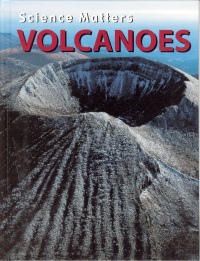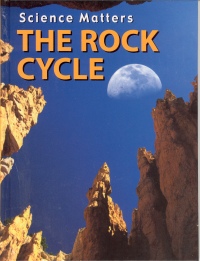| ________________
CM . . .
. Volume XI Number 12 . . . .February 18, 2005
There are six new books in this series. Two of them, Volcanoes and Earthquakes, deal with nature disasters; the other four, Rocks, The Rock Cycle, Minerals, and Fossils, are concerned with the composition of the earth. The format of each volume is similar. They begin by defining their basic area of interest, explaining what people studying this area are called and saying a little about how they do their job, before going on to expand on the subject. In almost all the books (Fossils being the exception), there is a very clear diagram of the subject of the book, carefully identifying terms used. (Rocks and The Rock Cycle have the same diagram, one of several points of overlap of these two volumes.) Several of the books include very slight biographies of an influential scientist who contributed significantly to study in the field, and most have a mythical tie-in which could well intrigue young readers. They might enjoy the concept of an earthquake's occurring when one of the eight elephants holding up the [flat] earth falls asleep and shakes his head to wake himself up, though the horrific results deny the charm of the image. (Yes, tsunamis are mentioned in Earthquakes, but no details are given as they would have been had the book been published after the South-East Asian disaster.) All the books finish with a couple of pages of questions to help you consolidate "What You Have Learned," a page of how and where you can pursue your interest in the subject that includes useful terms to google as well as one website to try, and a page of index and glossary. The glossary defines words printed in boldface in the text. All of the books are copiously illustrated. It is apparently the policy of the series editors that the pictures not be, strictly speaking, labeled, but instead have an interesting fact printed beneath them. This works well enough in the rocks and fossils books, but less well in the disaster ones. In Earthquakes, for example, a picture of a house at a forty-five degree angle surrounded by piles of twisted ironwork, which cries out for a when?, where?, how strong? label, is captioned "An earthquake occurs somewhere in the world every 30 seconds. Most are too small to cause any damage." Oh, really? The design of the books is good, using a large font and text limited to a couple of small paragraphs per page. The vocabulary is aimed at children in about Grades 2 to 4 (ages 7-10), with technical terms largely restricted to those which could be considered household words in the subject. One exception to this was in Volcanoes which defines different types of lava by their Hawaiian names, which I thought an unnecessary addition. Definitions are necessarily simple and incomplete, but correct as far as they go. Given that children are more likely to be drawn to the "violent" books, it is a pity that the "earthy" ones struck me as giving a better and more interesting picture of their subjects. The main problem with the books is that they are attempting to deal with complicated material at a very simple level and may create confusion rather than elucidation. It is hard to say anything very meaningful at the level at which these are written, instead making bald, correct, statements that have very little content. In fact, they all reminded me of a newspaper headline over an interview with an eminent geographer which said: "Scientist says rain causes flooding." True, but not a useful contribution to the subject. On the whole, however, the series is well worth space on the shelves of an elementary school to satisfy requests for "a book about..." from very young students who prefer facts to fiction. Recommended. Mary Thomas works in two elementary school libraries in Winnipeg, MB, and will gladly make room for the books on their shelves.
To comment
on this title or this review, send mail to cm@umanitoba.ca.
Copyright © the Manitoba Library Association. Reproduction for personal
use is permitted only if this copyright notice is maintained. Any
other reproduction is prohibited without permission.
NEXT REVIEW |
TABLE OF CONTENTS FOR THIS ISSUE
- February 18, 2005.
AUTHORS |
TITLES |
MEDIA REVIEWS |
PROFILES |
BACK ISSUES |
SEARCH |
CMARCHIVE |
HOME |





